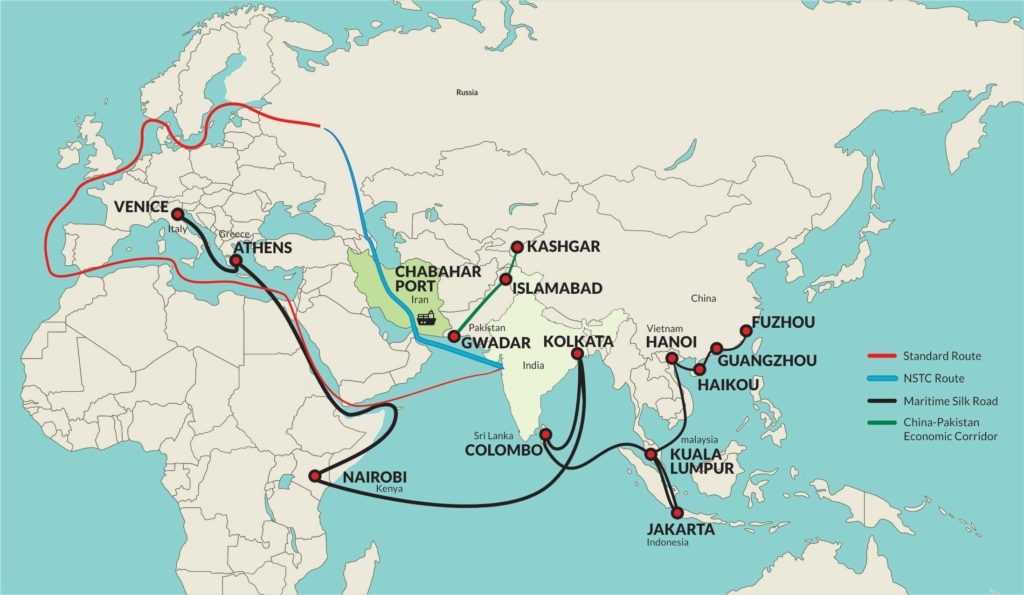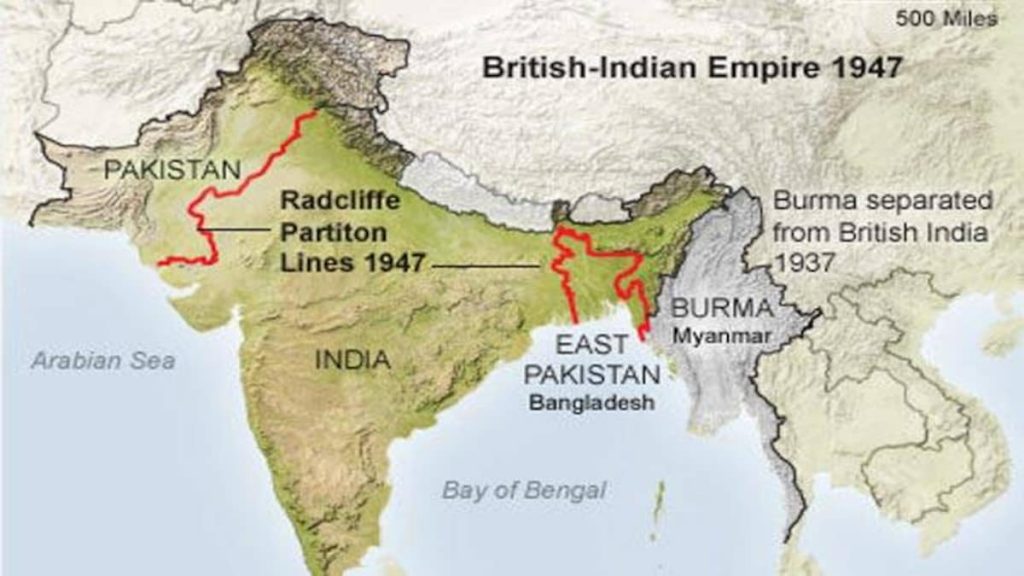Contents
- Iran drops India from Chabahar rail project
- Iran and China draft 25-year trade, military agreement
- Pakistan to allow Afghan exports through Wagah border
- SC on Padmanabhaswamy Temple administration
- Aircraft carriers to get Indian jets by 2032
IRAN DROPS INDIA FROM CHABAHAR RAIL PROJECT
Focus: GS-II International Relations
Why in news?
Four years after India and Iran signed an agreement to construct a rail line from Chabahar port to Zahedan, along the border with Afghanistan, the Iranian government has decided to proceed with the construction on its own.
The development comes as China finalises a massive 25-year, $400 billion strategic partnership deal with Iran, which could cloud India’s plans.
Reason for Exclusion of India from the project
Iran has cited delays from the Indian side in funding and starting the project as the reason.
Trilateral agreement
- The railway project, which was being discussed between the Iranian Railways and the state-owned Indian Railways Construction Ltd (IRCON), was meant to be part of India’s commitment to the trilateral agreement between India, Iran and Afghanistan to build an alternate trade route to Afghanistan and Central Asia.
- In 2016, when Chabahar agreement was signed between India, Iran and Afghanistan, IRCON had signed an MoU with the Iranian Rail Ministry.
- IRCON had promised to provide all services, superstructure work and financing for the project.
- India never began the work, ostensibly due to worries that these could attract U.S. sanctions.
- It has been difficult to find equipment suppliers and partners due to worries they could be targeted by the U.S.
Chabahar Port

This port is Located on the Gulf of Oman and is the only oceanic port of the country.
- With this, India can bypass Pakistan in transporting goods to Afghanistan.
- It will also boost India’s access to Iran, the key gateway to the International North-South Transport Corridor that has sea, rail and road routes between India, Russia, Iran, Europe and Central Asia.
- It also helps India counter Chinese presence in the Arabian Seawhich China is trying to ensure by helping Pakistan develop the Gwadar port. Gwadar port is less than 400 km from Chabahar by road and 100 km by sea.
- With Chabahar port being developed and operated by India, Iran also becomes a military ally to India. Chabahar could be used in case China decides to flex its navy muscles by stationing ships in Gwadar port to reckon its upper hand in the Indian Ocean, Persian Gulf and Middle East.
- Trade benefits: With Chabahar port becoming functional, there will be a significant boost in the import of iron ore, sugar and rice to India. The import cost of oil to India will also see a considerable decline. India has already increased its crude purchase from Iran since the West imposed ban on Iran was lifted.
- From a diplomatic perspective, Chabahar port could be used as a point from where humanitarian operations could be coordinated.
-Source: The Hindu
IRAN AND CHINA DRAFT 25-YEAR TRADE, MILITARY AGREEMENT
Focus: GS-II International Relations
Why in news?
Iran and China have drafted an economic and security partnership that would allow for billions of dollars in Chinese investments in energy and other sectors – including the military.
Details
- With this move China would expand its presence in Iran’s banking and telecommunications sectors as well as railways, ports and other projects.
- In exchange of this investment, Iran would supply Beijing with a heavily discounted supply of oil over the next 25 years.
- China is a key market for Iranian crude oil exports, which have been dampened by US economic sanctions.
- The deal would allow China to gain a foothold in a region where the US has had strategic residence for the last few decades.
- China has been stepping up its military cooperation with Iran over the past decade.
Reading the move from India’s Perspective
- The US – China tussle arriving in Iran would be a new challenge within a challenge for New Delhi, which has over the past few years been balancing its relations with the US and Iran.
- For India, an extensive economic and security pact between Iran and China raises some critical concerns.
- The Chabahar port project, often scene as India’s strategic magnum opus in Iran, is also envisaged as a bridge between India, Iran, Afghanistan and Central Asia.
- Iran has not shied away by leveraging both China and Pakistan as potential investors for the Chabahar Special Economic Zone, challenging Indian public narratives of Chabahar seemingly being an India-exclusive project.
- Iran has also decided to build the rail line connecting Chabahar with Zahedan on the Afghan border alone, citing delays in funding from India.
- The development of Chabahar has often come under duress due to financial, political and diplomatic largess by both India and Iran, and also due to US pressure along with sanctions blocking most legitimate financial highways to and from Iran.
- For India, going forward after the almost-war like situation with China in Ladakh, an institutionalized slide towards the US today may potentially come at the price of hedging itself over Iran as per Trump administration’s narratives.
- However, the modalities of an Iran – China strategic partnership would be of vital interest to India not only as part of its relations with Tehran, but more importantly as per China’s access to the Indian Ocean region, connecting via Gwadar, Djibouti and possible permanent military accesses arrangement with Iran.
-Source: The Hindu, New York Times
PAKISTAN TO ALLOW AFGHAN EXPORTS THROUGH WAGAH BORDER
Focus: GS-II International Relations
Why in news?
Pakistan will allow Afghanistan to send goods to India using the Wagah border.
Details
- The decision, which is part of Islamabad’s commitment under Pakistan-Afghanistan Transit Trade Agreement, is expected to boost Afghanistan’s exports to India.
- India had cancelled the Most Favoured Nation status for Pakistan in the aftermath of the Pulwama attack.
- The announcement from Pakistan has come at a time when Afghanistan’s melon harvesting season is at its peak and the availability of the Indian market is expected to help its economy.
Afghanistan–Pakistan Transit Trade Agreement
- The Afghanistan–Pakistan Transit Trade Agreement (also known as APTTA) is a bilateral trade agreement signed in 2010 by Pakistan and Afghanistan that calls for greater facilitation in the movement of goods amongst the two countries.
- In 2017, the President of Afghanistan announced that The Afghanistan and Pakistan Trade Agreement (APTA) has expired, and issued a decree banning Pakistani trucks from entering the country via the Torkham and Spin Boldak border crossings.
- The 2010 APTTA allows for both countries to use each other’s airports, railways, roads, and ports for transit trade along designated transit corridors.
- The agreement does not cover road transport vehicles from any third country, be it from India or any Central Asia country.
Wagah Border
- The Wagah border crossing draws its name from Wahga village, near which the Radcliffe Line, the boundary demarcation line dividing India and Pakistan upon the Partition of British India, was drawn.
- At the time of the independence in 1947, migrants from India entered Pakistan through this border crossing.
Wagah-Attari border ceremony
- The Wagah-Attari border ceremony happens at the border gate, two hours before sunset each day.
- The flag ceremony is conducted by the Pakistan Rangers and Indian Border Security Force (BSF).
- A marching ceremony, known as the “Silly Walk ceremony”, is conducted each evening along with the flag ceremony.
Radcliffe Line

- On 17 August 1947, the borderline that separated India from Pakistan, known as the Radcliffe Line was revealed.
- The Radcliffe line is spread through the Rann of Kutch in Gujarat till international border in Jammu in Jammu & Kashmir, dividing India and Pakistan into two different countries.
- The Radcliffe line divided India into 3 parts: India, East Pakistan and West Pakistan.
- This border line is today the international boundary between India and Pakistan on the western side and between India and Bangladesh on the eastern side.
- Before independence, it was decided to partition India into India and Pakistan for the Hindu and Muslim communities respectively.
- The provinces of Sindh and Baluchistan with an overwhelming majority of Muslims (more than 70% and 90% respectively) were granted to Pakistan.
- The provinces of Punjab and Bengal only had a marginal majority of Muslims. Punjab had 55.7% of Muslims and Bengal had 54.4% Muslims. Even though Muhammad Ali Jinnah wanted these provinces to go to Pakistan in their entirety, the Congress Party did not agree considering the feelings of the Hindu and Sikh populations.
- It was decided to cut through these provinces and give portions to both countries.
-Source: The Hindu
SC ON PADMANABHASWAMY TEMPLE ADMINISTRATION
Focus: GS-I Art and Culture
Why in news?
The Supreme Court held that the erstwhile Travancore royal family is the “human ministrant” or the shebait (manager) of the properties belonging to Sri Padmanabha, chief deity of the famed and fabulously rich Sri Padmanabhaswamy temple in Kerala.
Details
- Arguments were raised both to and fro on whether the 26th Constitutional Amendment, which banished rulers and privy purses, would nudge the temple and properties into the hands of the State.
- The Kerala High Court, in 2011, directed the State to take over the temple and exhibit its treasures for public viewing in a museum.
- Shebaitship was always in the royal family and the Ruler represented the unbroken line of shebaits.
- The court defined ‘shebait’ as the “custodian of the idol, its earthly spokesman, its authorised representative entitled to deal with all its temporal affairs and to manage its property”.
- It also ordered a second committee to be constituted to advise the administrative committee on policy matters.
Historical Reference
- The court traced how the shebaitship descended from King Marthanda Varma, who rebuilt the temple and installed a new idol after a fire destroyed the temple in 1686.
- It referred to how the King surrendered his kingdom in 1750 and assumed the role of ‘Padmanabhadasa’ after realising “the futility of battles as a means to an end and the conscious feeling that the Travancore he created was built on a foundation of sacrifice of the liver and limbs of countless numbers who fell due to him and for him.”
Padmanabhaswamy Temple
- The Padmanabhaswamy temple is a Hindu temple located in Thiruvananthapuram, the state capital of Kerala, India.
- The temple is built in an intricate fusion of the Chera style and the Dravidian style of architecture, featuring high walls, and a 16th-century gopura.
- The temple is a replica of the Adikesava Perumal temple in Thiruvattar.
- The principal deity is Padmanabhaswamy (Vishnu).
-Source: The Hindu
AIRCRAFT CARRIERS TO GET INDIAN JETS BY 2032
Focus: GS-III Internal Security Challenges
Why in news?
- The Navy is expected to get the Hindustan Aeronautics Ltd. (HAL)-built twin-engine carrier aircraft by 2032. It will replace the MiG-29Ks in service which are scheduled to start going out by 2034.
- The Navy currently operates Russian-origin carrier INS Vikramaditya and expects to have the first Indigenous Aircraft Carrier (IAC-I) Vikrant operational by 2022. With a second carrier to come in, the Navy is already evaluating a global tender for 57 carrier-based twin-engine fighter aircraft.
- The Navy currently has 45 Russian MiG-29K aircraft and its officials had stated that there will not be enough aircraft to operate from both carriers.
Points for prelims
- The Indian Navy currently operates one aircraft carrier, INS Vikramaditya (Procured from Russia and later modified)
- The second, INS Vikrant (Also called as Indigenous Aircraft Carrier (IAC-I)), is under construction by Cochin Shipyard in Kochi, due for commissioning in 2022.
China currently has two aircraft carriers, with a third in early construction, and a fourth planned for some time in the mid 2020 or 2030s.





